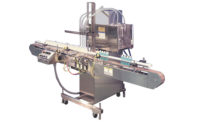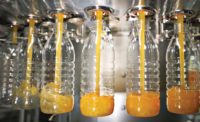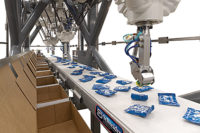As brands expand their portfolios to include a variety of beverages, they require automated mixing and blending systems that are flexible enough
to handle different types of batches efficiently. To accommodate the varying ingredients and functional claims associated with these different products, beverage-makers seek to utilize automated systems that can handle this complexity and depth within a portfolio, explains Kevin Henretta, chief engineer for SensiBlend and chief technical officer of Hygeia Industries Inc., the brand’s Wilmette, Ill.-based parent company.
“The sports drink market is a great example,” Henretta says. “The number of ingredients is increasing as sports drinks are really becoming more like energy drinks or health drinks with double-digit numbers of ingredients. The depth refers to the many different variations that now exist — different flavors, caffeine versus non-caffeine, real sugar versus artificial sugar, targeted toward men’s health or women’s health, etc. An automated system that can adapt from one product to the next and hit a wide range of capacities is desired when the product range is like this.”
To manage the specifications of different batches, flexible recipe management systems and agile control systems that easily adapt to control new ingredient delivery systems are a must, notes David McCarthy, president and chief executive officer of TriCore Inc., a Racine, Wis.-based systems integration firm.
Charles Ross & Son Co., Hauppauge, N.Y., includes recipe control packages on all of its mixing, blending and dispersion equipment, according to General Manager Gary Barber. A standard package consists of 10 recipes using 10 steps based on mixer speed and time, he explains. Other parameters, including temperature, vacuum level and batch weight, also can be programmed into the mixer controls, he adds.
To make these controls even more accessible and user friendly for greater control, the company released last fall a new line of Ross SysCon Recipe Controls that allow users to monitor and control a mixer’s human-machine interface remotely from a smartphone or tablet, Barber says. These systems can be configured to automatically send text or email messages about operating status, production concerns or alarm notifications so operators and managers can save time and stay constantly connected to the equipment, he explains.
Empowered by data
Technological advancements like this are indicative of a larger trend within processing automation to gather more data about the efficiency of these processes. TriCore’s McCarthy notes that manufacturers can look to processing data to increase efficiency and minimize downtime. The relatively inexpensive cost of digital storage data makes it practical to constantly measure equipment performance and product properties and store that data for analysis over time, he says. “[This] can provide deep analytical insight into the efficiency and operations of processing equipment and allow for corrective actions and optimizations that were not possible even a few years ago,” he explains.
Data also can be used to ensure individual batch as well as batch-to-batch consistency in mixing and blending processes, SensiBlend’s Henretta adds. SensiBlend’s patented smart-control technology, the SensiBlend automated skid system, takes real-time measurements of the chemical make-up of liquids at the point of blending and uses the measurements to automatically adjust proportioning, Henretta explains.
Typically, the system measures pH, conductivity, infrared and near-infrared (IR/NIR) light absorbance, and ultraviolet and visible (UV/VIS) light absorbance, Henretta says. Throughout the mixing and blending process, the sensors track the different measurements simultaneously and then use this data at the point of blending to automatically make slight adjustments to the proportioning in real time to ensure that the product is in spec throughout the entire process, Henretta explains. This can be especially crucial if an ingredient tank needs to be replaced in the middle of processing, he notes. “[If] the new tank is slightly different in concentration from the last one, the system will see this difference through the measurements and immediately adjust to keep the product at the outlet looking the same,” he says.
These measurements also can help with monitoring hard-to-measure ingredients. For example, sugar content is typically measured by Brix, a measure of density, Henretta says. However, artificial sweeteners have much lower gram per volume targets in order to achieve the desired taste and, therefore, have little effect on the density, he notes. In SensiBlend’s approach, infrared light is used to measure the exact concentration of molecules that are found in sugar, natural alternatives and artificial alternatives, as well as combinations of all three sweeteners, he explains.
In adjusting to ensuring consistency and preciseness, this method of measuring and adjusting proportions also promotes ingredient efficiency. “The end goal with these relatively expensive ingredients is to reach the desired proportion while minimizing waste,” he explains. “SensiBlend minimizes waste by making more in-spec product and eliminating bad batches.”
Clean changeover
Beverage-makers also work to reduce bad batches by properly cleaning the equipment between batches as needed.
Because the trend of SKU proliferation calls for smaller batch sizes, changeovers that might require cleaning are more frequent, TriCore’s McCarthy explains. As such, these changeovers need to be quick and efficient in order to minimize downtime and keep production levels up, he says.
For efficient cleaning, automated mixing systems make use of the clean-in-place (CIP) method, says Rick Earley, beverage and dairy market manager at Manchester, N.H.-based Admix Inc.
Admix equipped its new Rotosolver high-shear mixer with a one-piece CIP mix head for efficient cleaning, the company says. Through this feature, the Rotosolver offers intense mixing vortex control as well as the ability to wet out powders and can be easily cleaned afterward, it says.
CIP technology cleans and sanitizes the equipment without requiring an operator to take it apart, thus eliminating the time required to disassemble and reassemble the equipment as required in the clean-out-of-place method, TriCore’s McCarthy explains.
To focus on environmental efficiency in cleaning, TriCore has been retrofitting CIP systems with electrochemical activation systems, McCarthy says. “Such systems not only clean processing equipment much faster, adding greatly to equipment availability,” but they also do so without the use of hazardous chemicals that are common in traditional CIP systems, he explains.
Efficiency will continue to be important in the coming years as SKU, beverage complexity and ingredient proliferation trends continue, SensiBlend’s Henretta notes. These trends also will continue to require flexibility to handle any new products that come onto production lines, he says. Processing automation technology will allow mixing and blending equipment to continue to adapt to industry needs for handling different formulations and capacities and enable smaller plants to handle more complex product ranges as they expand their businesses.






